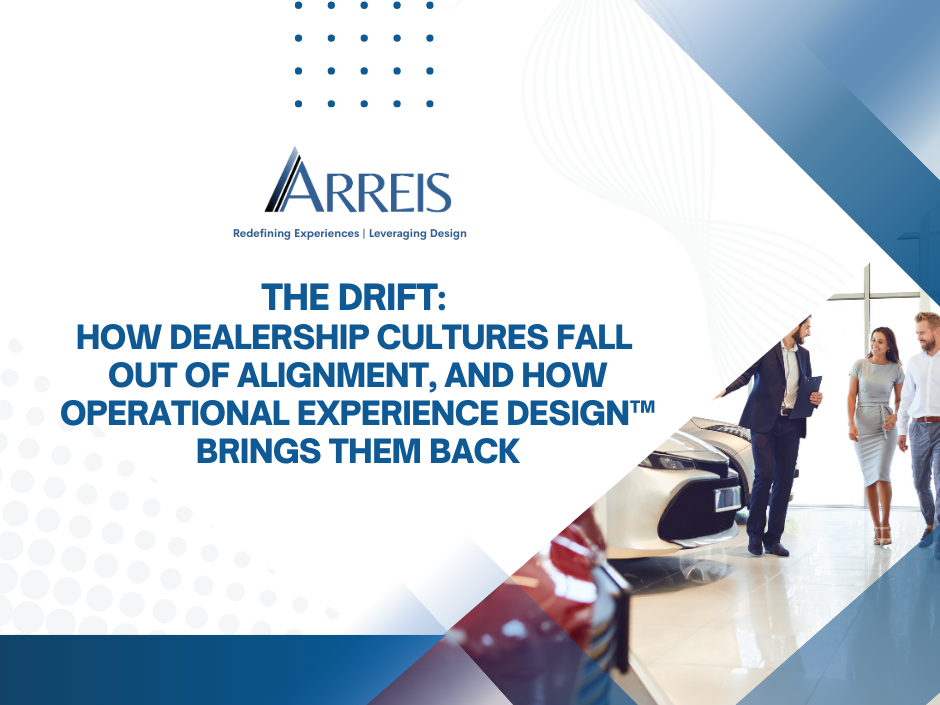Why Operational Flow is the Unsung Hero of Dealership Success
- Kelley Reis

- Oct 14
- 4 min read
Updated: Oct 20

Good Looks Aren’t Enough
A dealership that looks impressive but operates inefficiently is like a luxury car with no engine. It turns heads, but it doesn’t get you very far.
While aesthetics often dominate the early stages of facility planning, true success lies in something less visible: operational flow.
At Arreis, we believe great design isn’t just about visual impact, it’s about creating environments that work as well as they look. When every inch of your space supports seamless movement, communication, and function, your dealership becomes more than beautiful, it becomes powerful.
What Is Dealership Operational Flow, and Why It Matters
Operational flow is the intentional choreography of space, movement, and interaction within your dealership. It considers how employees navigate their tasks, how customers move through the experience, and how each area connects to the next.
Without it, even the most stunning showrooms suffer from:
Bottlenecks between departments
Awkward or inefficient staff workflows
Disconnected customer journeys
Increased stress and miscommunication
Lost time, lost trust, and lost revenue
With it? Everything changes.
How Thoughtful Layout Transforms Performance
1. Fewer Bottlenecks, Faster Processes
Strategic space planning helps eliminate the physical and procedural roadblocks that slow your team. Whether it’s service check-ins, vehicle delivery, or parts access, flow means function.
2. Improved Communication Across Teams
Physical layout directly impacts communication. Open sightlines, intentional adjacency (like placing the finance office near the delivery area), and shared spaces encourage faster decisions and fewer dropped handoffs.
3. Elevated Customer Experience
An efficient space communicates professionalism. Customers don’t want to be shuffled between departments or wait in forgotten corners. When movement is seamless, trust grows, and sales close faster.
Design Decisions That Drive Operational Efficiency
Here are four strategies we use with our clients:
A. Map Your Daily Movements
Before sketching a layout, walk in your team’s shoes. Where are the friction points? Where do people double back? What slows them down?
This insight becomes the foundation of a smart, customized design plan. For additional ideas on dealership operations and layout optimization, explore this CBT News article on wayfinding and customer navigation, which highlights how thoughtful design and spatial awareness can improve both staff workflow and customer experience.
B. Eliminate Dead Zones
Most dealerships have wasted space. Transform it into something useful: a digital delivery zone, quiet customer lounge, or quick-handoff area for techs.
C. Zone Your Spaces Intentionally
Separate loud from quiet, fast-paced from focused. Activity-based zoning reduces distractions and increases productivity.
D. Design with Future Growth in Mind
Your layout should support scale. That means adaptable workstations, smart wiring, and flexibility built into your space, so you’re not redoing it all in two years.
Case in Point: When Form Followed Function
One Arreis client had recently renovated a beautiful showroom, but behind the scenes, it was a maze. Service techs crossed paths with customers, parts were stored far from where they were needed, and team communication suffered.
We stepped in and redesigned the internal layout with a focus on flow and proximity. The transformation was immediate: service moved faster, collaboration improved, and the customer experience became more seamless.
When form follows function, performance naturally improves.
Where Many Dealerships Get It Wrong
Too often, leaders prioritize “wow” design or brand aesthetics, but forget the basics of operational flow.
Common pitfalls:
Departments spaced too far apart
Prioritizing “tour appeal” over daily needs
No workflow mapping before building
Overdecorating areas at the expense of function
Fancy lounges nowhere near service zones
At Arreis, we always ask: Does this space support its purpose?
If the answer is no, it’s time to realign your approach. For deeper insight into how layout design influences customer behavior and operational efficiency, explore Wavetec’s article on improving retail layouts to enhance customer flow. It outlines practical strategies for reducing friction and designing environments that support both people and performance.
The Link Between Design and Team Culture
Operational flow shapes how your people feel. When your space:
Reduces task friction
Supports organic communication
Respects quiet and focused zones
…your team feels empowered and productive.
This kind of environment attracts stronger talent, builds trust, and fuels retention.
Want to boost morale? Start with your floorplan.
Operational Flow as a Customer Experience Strategy
Most dealerships separate “customer experience” from “operations.” But the best-performing ones know they’re deeply connected.
Think about it:
A customer who doesn’t wait
A sales rep who doesn’t waste time chasing down F&I
A service guest who’s welcomed, guided, and cared for
These aren’t happy accidents, they’re business strategies. All driven by layout.
Ready to Rethink the Way Your Dealership Works?
If you’re opening a new facility, or frustrated with your current one, let’s talk.
We’ll walk through:
Current layout vs ideal flow
Team traffic mapping
Operational pain points
Customer journey alignment
Your space should help your people, and your customers, thrive.
Frequently Asked Questions
What’s the first step in improving operational flow?
Start with a walkthrough and staff input. You’ll uncover the biggest friction points fast.
Can you help with existing dealerships or only new builds?
Both. Our expertise is rooted in supporting real-world improvements at any stage.
Do you work with small or independent dealerships?
Absolutely. Operational design matters at every size and scale.



Comments